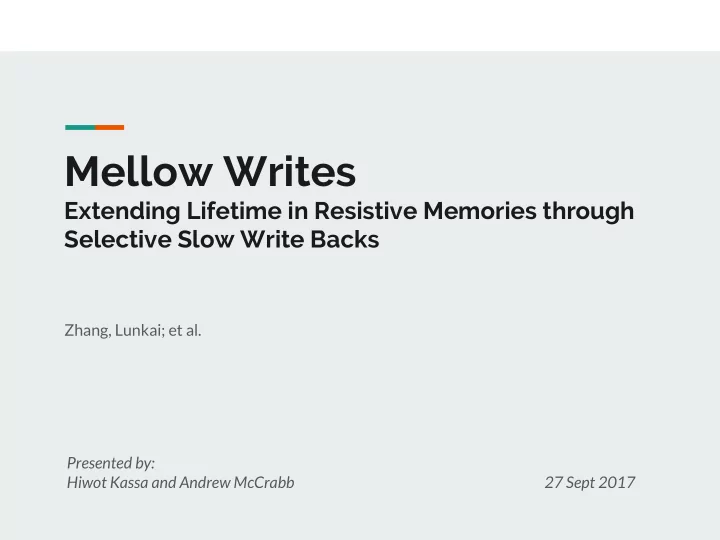

Mellow Writes Extending Lifetime in Resistive Memories through Selective Slow Write Backs Zhang, Lunkai; et al. Presented by: Hiwot Kassa and Andrew McCrabb 27 Sept 2017
Motivation Endurance PRAM and ReRAM have short write-endurance ● Current solutions: Reduce the number of writes ● e c n a m r o f Switching speed is inversely ● r e P proportional to write endurance . Switching Speed Memory banks often have long idle time. ●
Prior Work: Slow Writes* Fast writes need high power ● High power damages memory cells ● Slow writes: allow write operation to take longer to reduce damage ● *Information from this slide comes from Dr. Strukov’s paper See References
Research Objective Performance E n d u r a n c e Optimize when to make writes “Slow” ● Improve memory lifetime to 8 years ● Minimize Area/Energy Overhead ● Switching Speed
Solution - 1. Bank-Aware Mellow Writes Execute SLOW Writes when no other read/write requests are waiting ● Slow Write Latency = 3x Normal ○ Slow/Normal Decisions are ● bank specific Only Bank 1 may execute ● a slow write Zhang [1]
Solution - 2. Eager Mellow Writes Include additional queue for data you don’t need again ● Execute when no other read/write requests are queued ● Utilizes bank idle time ● without performance loss Zhang [1]
Solution - 3. Wear Quota Failure Threshold FAILURE Limit number of normal writes ● Total Write Damage in a sampling period After “X” normal writes, use ● only slow writes Guarantee lifetime with ● occasional performance loss Time Guaranteed Lifetime
Solution - continued Bank aware mellow write mechanism to detect bank conflict in the read and write queues ● Eager mellow write allows the cache to eagerly write back some dirty data ● the LLC needs to identify what items to use as candidates for Eager Mellow Writes ● Wear quota divide the execution period into multiple sample periods and the memory ● controller calculates .
Putting it all together Eager mellow Bank aware write mellow write Request on Exceeds yes No the same wear bank? quota? No Slow write Normal write yes
Experimental Evaluation OoO Core, Alpha ISA , 12 memory-intensive ● workloads From conference presentation on this paper
Results 2.58x lifetime and 1.06x performance ● 8 years life time with minimal performance degradation ● High bank utilization // Less memory idle time ● 39% more energy consumption in main memory system ● Lifetime increases with more memory banks (figure below) ●
Technical Insights Reducing high-speed write operations can help guarantee a ● minimum lifetime. We can maintain performance by optimizing slow-write placements. ● Utilizing memory idle time costs minimal extra energy and area. ●
Conclusion for non-volatile memories, there exists an endurance advantage to ● performing writes slowly using a smaller write dissipated power a combination of two Mellow Writes schemes extends lifetime with ● minimal performance impact Wear Quota can guarantee the minimal expected lifetime with small ● performance loss.
Discussion Is there a benefit to having multiple latencies? (e.g. 1x, 3x, and 20x ● write latencies) Would this help or hurt write-intensive applications? ● Should “Wear Quota” be included in other platforms (mobile, server, ● etc)? References D. B. Strukov, “Endurance-write-speed tradeoffs in non-volatile memories,” Applied Physics A, vol. 122, no. 4, pp.1–4, 2016. Zhang, Lunkai et al. , “Mellow Writes: Extending Lifetime in Resistive Memories through Selective Slow Write Backs,” ISCA, Seoul, South Korea, June 2016
Recommend
More recommend